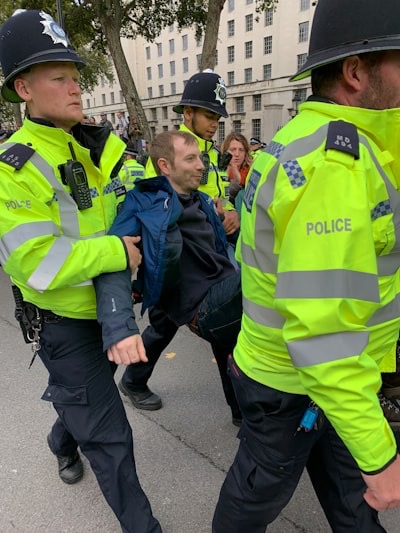Police Strategy Against Drugs: Effective Techniques
Police Strategies in the War Against Drugs

Key Highlights
- The war against drugs in the United States has shaped by various factors, including the fragmented law enforcement system and restrictions on police authority.
- Traditional enforcement strategies such as street-level arrests and interdiction efforts have not been successful in reducing drug supply or abuse.
- Promising approaches include community policing, problem-oriented policing, and a focus on drug demand reduction.
- Collaboration with other agencies and the community plays a role in drug prevention and treatment.
- Tactical approaches to drug enforcement involve specialized drug task forces and high-tech surveillance and intelligence gathering.
Introduction

The issue of drug abuse has been a longstanding challenge for societies around the world, and the United States is no exception. The so-called "war on drugs" has been a key aspect of drug control efforts in the country, with law enforcement agencies playing a central role in combating drug trafficking and reducing drug abuse in America. This blog will explore the various strategies and approaches employed by law enforcement in the ongoing battle against drugs.
Understanding the War on Drugs
The war on drugs refers to the set of policies and actions aimed at reducing drug abuse and drug trafficking. In the United States, this war has been fought primarily through the criminal justice system, with law enforcement agencies at the forefront. However, the effectiveness of this approach has been a subject of debate, as drug problems in the country continue to persist. It is important to understand the history and evolution of drug policies in order to better comprehend the strategies employed by law enforcement agencies.
A Brief History and Evolution of Policies
The United States has a complex history when it comes to drug policy. In the early 20th century, the federal government began to exert more control over drug regulation and enforcement. The passage of the Comprehensive Drug Abuse Prevention and Control Act in 1970 marked a significant shift in drug policy, focusing on criminalizing drug use and trafficking. Since then, various legislation and initiatives have been implemented to combat drug abuse and reduce drug supply. However, the effectiveness of these policies has been a topic of ongoing debate.
Key Legislation Impacting Police Strategies

One key legislation that has impacted police strategies in the war against drugs is the Law Enforcement Action Partnership (LEAP). LEAP is an organization composed of current and former law enforcement professionals who advocate for a shift in drug policy from a criminal justice approach to a public health approach. This shift involves treating drug abuse as a public health issue rather than a criminal offense. Another important legislation is the Narcotic Control Act, which provides law enforcement with the legal framework to combat drug trafficking and control the distribution of narcotics. Additionally, the input and expertise of Police Captain Peter Christ (Ret.) have been crucial in shaping LEAP's approach to drug policy reform.
The Role of Law Enforcement in Drug Prevention


Law enforcement agencies play a crucial role in drug prevention efforts. One approach that has gained recognition is community policing, which involves building strong relationships between law enforcement officers and the community. By engaging with the community, law enforcement can gain valuable insights into drug abuse patterns, identify at-risk individuals, and provide resources for drug treatment and prevention. The focus is on addressing the root causes of drug abuse and promoting public health outcomes.
Community Policing and Drug Awareness Programs

Community policing is a proactive approach to law enforcement that aims to strengthen the relationship between the police and the community they serve. When it comes to drug prevention, community policing can be instrumental in raising awareness and educating the public about the dangers of drug abuse. Some key components of community policing and drug awareness programs include:
- Establishing partnerships with community organizations, schools, and healthcare providers to promote drug prevention initiatives.
- Conducting educational campaigns to inform the public about the risks of drug abuse and available resources for treatment and support.
- Collaborating with local businesses to address issues related to drug trafficking and illicit drug use in the community.
- Implementing community-based interventions such as neighborhood watch programs and drug take-back events to address drug-related crimes and reduce drug availability.
Collaboration with Other Agencies and the Community
Effective drug prevention and treatment require collaboration between law enforcement agencies, other government entities, and community organizations. Law enforcement officers can work closely with social service agencies, healthcare providers, and community-based organizations to ensure a holistic approach to addressing drug-related issues. Some strategies for collaboration include:
- Sharing information and resources to identify individuals in need of drug treatment and support.
- Coordinating efforts to provide comprehensive services, including mental health support, housing assistance, and job training, to individuals seeking recovery from drug addiction.
- Implementing joint initiatives to address the social determinants of drug abuse, such as poverty, lack of education, and limited access to healthcare.
- Engaging community members in the development and implementation of drug prevention and treatment programs, ensuring their voices are heard and their needs are addressed.
Tactical Approaches to Drug Enforcement
Tackling drug trafficking and the distribution of illicit drugs requires strategic and tactical approaches by law enforcement agencies. These approaches aim to disrupt drug supply chains, apprehend drug traffickers, and dismantle criminal organizations involved in drug trafficking. Some key tactics employed by law enforcement in drug enforcement include:
- Use of specialized drug task forces that focus on investigating and dismantling drug trafficking networks.
- High-tech surveillance and intelligence gathering to gather evidence and track drug-related activities.
- Collaboration with other law enforcement agencies and international partners to combat transnational drug trafficking networks.
Use of Specialized Drug Task Forces
Specialized drug task forces play a critical role in targeting and dismantling drug trafficking organizations. These task forces are composed of highly trained police officers who focus specifically on investigating drug-related crimes. By dedicating resources and expertise to drug enforcement, specialized task forces can effectively disrupt drug supply chains, apprehend major drug traffickers, and seize illicit drugs. Some key aspects of specialized drug task forces include:
- Utilizing intelligence-led policing strategies to identify high-value targets and gather evidence for successful prosecutions.
- Coordinating with other law enforcement agencies at the local, state, and federal levels to share information and resources.
- Employing undercover operations and surveillance techniques to infiltrate drug trafficking organizations and gather actionable intelligence.
High-Tech Surveillance and Intelligence Gathering
The use of high-tech surveillance and intelligence gathering has become an essential tool in combating drug trafficking. Law enforcement agencies leverage advanced technology and data analysis to identify drug trafficking networks, track the movement of illicit drugs, and gather evidence for successful prosecutions. Some key aspects of high-tech surveillance and intelligence gathering include:
- Utilizing advanced surveillance equipment, such as cameras, drones, and intercept devices, to monitor drug-related activities.
- Leveraging data analytics and intelligence software to identify patterns and trends in drug trafficking.
- Collaborating with intelligence agencies and international partners to share information and coordinate efforts to disrupt drug trafficking networks.
Challenges Faced by Police in Drug Enforcement
While law enforcement plays a crucial role in drug enforcement, they also face various challenges in their efforts to combat drug trafficking and reduce drug abuse. Some of the key challenges include:
- Balancing civil liberties and police authority in drug enforcement operations.
- Addressing the changing nature of drug trafficking, which often involves sophisticated and organized criminal networks.
- Mitigating the risk of police violence and ensuring accountability in drug enforcement operations.
The Dilemma of Balancing Civil Liberties
The issue of balancing civil liberties and police authority is a complex one, especially in the context of drug enforcement. While law enforcement agencies have a responsibility to protect public safety and combat drug trafficking, they must also respect the rights and freedoms of individuals. Striking the right balance between effective drug enforcement and safeguarding civil liberties requires careful consideration and adherence to legal and ethical standards.
Dealing with the Changing Nature of Drug Trafficking
Drug trafficking is a constantly evolving challenge for law enforcement agencies. Criminal organizations involved in drug trafficking often adapt their strategies and tactics to evade detection and prosecution. Law enforcement agencies must stay vigilant and adapt their approaches to keep pace with these changes. This includes developing intelligence networks, leveraging technological advancements, and collaborating with international partners to effectively disrupt drug trafficking networks and reduce the availability of illicit drugs.
Innovative Strategies in Combating Drug Problems
In addition to traditional law enforcement approaches, innovative strategies have emerged in recent years to combat drug problems. These strategies focus on harm reduction, drug treatment, and addressing the underlying causes of addiction. Some innovative approaches include:
- Harm reduction initiatives that aim to reduce the negative consequences of drug use while providing support and resources to individuals struggling with addiction.
- Expansion of drug treatment programs that utilize evidence-based approaches to help individuals overcome addiction and achieve long-term recovery.
- Collaboration between law enforcement and healthcare providers to implement diversion programs that offer alternatives to incarceration for individuals with substance use disorders.
Emphasis on Harm Reduction Policies
Law enforcement officers often encounter drug users who have overdosed or are struggling with addiction. Recognizing the challenges faced by drug users, many officers support harm reduction policies that prioritize public health and safety over strict abstinence. These policies aim to help drug users stabilize their lives and reduce the negative consequences associated with drug use.
One of the most pressing issues in drug enforcement is the high rate of relapse among drug users. Even after receiving drug treatment, many individuals still struggle with mental health problems, homelessness, and unemployment, which often contribute to their relapse. Harm reduction policies in countries like Canada provide essential services to drug users, including access to clean needles, overdose prevention centers, and medication-assisted treatment. These initiatives not only save lives but also help drug users engage in treatment and support services that can assist them in achieving long-term recovery.
Focus on Treatment and Rehabilitation Over Incarceration
One of the challenges faced by law enforcement in the war against drugs is the cycle of addiction and incarceration. Many individuals struggling with drug addiction find themselves caught in a revolving door of arrest and incarceration, rather than receiving the necessary support and treatment they need to address the root causes of their addiction.
Recognizing the limitations of arrest and incarceration as effective strategies for addressing drug addiction, there is a growing emphasis on treatment and rehabilitation. Instead of punitive measures, law enforcement agencies are working to divert individuals with drug addiction issues into intensive support programs. These programs provide addiction treatment, mental health support, housing assistance, and job training to help individuals break free from the cycle of addiction and reduce recidivism rates.
Measuring the Success of Police Strategy Against Drugs
Measuring the success of police strategies against drugs is essential for evaluating the effectiveness of law enforcement efforts and allocating resources efficiently. Metrics for evaluation can provide valuable insights into the impact of different strategies and inform future decision-making.
Some key metrics for evaluating the success of police strategies against drugs include changes in drug supply and availability, reductions in drug-related crimes and violence, improvements in public health outcomes, and the engagement of communities in drug prevention and enforcement efforts. These metrics can help assess the overall effectiveness of police strategies and guide the development of evidence-based approaches in drug control.
America Metrics for Evaluation and Accountability
In evaluating the success of police strategies against drugs, it is important to establish clear metrics for evaluation and accountability. These metrics can help measure the impact of law enforcement efforts and hold agencies accountable for their performance.
Some key metrics for evaluation and accountability in drug enforcement include:
| Metric | Description |
| Reduction in drug-related crimes | Measure the change in the number and severity of drug-related crimes, such as drug trafficking, possession, and distribution. |
| Decrease in drug availability | Assess the impact of law enforcement efforts on reducing the availability of illicit drugs in the market. |
| Health outcomes | Evaluate the improvements in public health outcomes, such as reductions in drug-related deaths, HIV and Hepatitis C transmission rates. |
| Community engagement | Measure the level of community involvement and support in drug prevention and enforcement efforts. |
By establishing these metrics and regularly monitoring progress, law enforcement agencies can improve their strategies and ensure accountability in their efforts to combat drug abuse and trafficking.
Case Studies of Effective Drug Enforcement Operations
Examining case studies of effective drug enforcement operations can provide insights into successful strategies and approaches used by law enforcement agencies. These cases highlight the importance of intelligence-gathering, collaboration between agencies, and targeted enforcement efforts.
One such case study is the dismantling of a major drug trafficking network that spanned multiple countries. Through international cooperation, law enforcement agencies were able to gather intelligence, conduct coordinated operations, and disrupt the supply chain of illicit drugs. This case demonstrated the effectiveness of strategic partnerships and the use of advanced investigative techniques in combating drug trafficking.
Another case study involves a community-based approach to drug enforcement. By working closely with community members, law enforcement agencies were able to gather valuable information, build trust, and effectively target drug-related activities in specific neighborhoods. This approach not only led to successful arrests and seizures but also contributed to long-term community safety and drug prevention efforts.
The Impact of International Drug Policies on Local Enforcement
The impact of international drug policies on local enforcement is significant, as drug trafficking and drug abuse are global issues that require cooperation and collaboration among nations. International drug policies set the framework for cooperation, information sharing, and joint operations among law enforcement agencies.
Global cooperation efforts aim to disrupt drug trafficking networks, share intelligence, and coordinate enforcement actions across borders. These efforts help address the transnational nature of the drug trade and prevent drug traffickers from exploiting jurisdictional boundaries.
Local enforcement agencies rely on international cooperation to gather intelligence, track drug flows, and intercept illicit drugs before they reach local communities. By working together, law enforcement agencies can enhance their effectiveness in combating drug trafficking and protecting public safety.
Global Cooperation Efforts and Their Local Effects
Global cooperation efforts play a crucial role in addressing the challenges posed by drug trafficking and drug abuse. These efforts involve collaboration between countries, international organizations, and law enforcement agencies to share intelligence, coordinate operations, and implement effective drug control strategies.
By sharing information and resources, global cooperation efforts enhance the capacity of local law enforcement agencies to combat drug trafficking and address the root causes of drug abuse. Through joint operations and intelligence sharing, countries can disrupt drug supply chains, dismantle criminal networks, and prevent the flow of illicit drugs into local communities.
Global cooperation efforts also promote the adoption of evidence-based drug policies and best practices in law enforcement. By learning from successful approaches implemented in other countries, local law enforcement agencies can improve their strategies and enhance their effectiveness in combating drug-related crimes.
Adapting to International Drug Trade Dynamics
The international drug trade is dynamic and constantly evolving, posing challenges for law enforcement agencies around the world. To effectively combat drug trafficking, law enforcement agencies must adapt to the changing dynamics of the global drug trade.
Drug traffickers often exploit new routes, concealment methods, and technological advancements to evade detection and interception. Law enforcement agencies need to stay ahead of these developments by enhancing intelligence-gathering capabilities, leveraging advanced technologies, and collaborating with international partners.
Additionally, effective enforcement strategies require a comprehensive understanding of the underlying factors driving the drug trade. This includes analyzing socio-economic factors, geopolitical dynamics, and emerging trends in drug production and consumption. By staying informed and adapting their strategies accordingly, law enforcement agencies can effectively disrupt drug trafficking operations and protect communities from the harmful effects of illicit drugs.
Conclusion
In conclusion, the fight against drug abuse necessitates a multifaceted approach that combines legislative backing, community involvement, and innovative enforcement tactics. Law enforcement agencies play a pivotal role in drug prevention through community policing initiatives and strategic partnerships. Balancing civil liberties while combating evolving drug trafficking challenges remains a critical dilemma. Emphasizing harm reduction, treatment, and rehabilitation over punitive measures showcases progressive strategies in addressing drug-related issues. Evaluating the effectiveness of these approaches through measurable metrics and real-life case studies is imperative for refining future drug enforcement policies. Additionally, global cooperation and adaptation to international drug trade dynamics are vital for aligning local enforcement efforts with broader international objectives.
Frequently Asked Questions
What Are the Most Effective Police Strategies in Drug Enforcement?
The most effective police strategies in drug enforcement include a combination of approaches such as community policing, problem-oriented policing, intelligence-led operations, and international cooperation. These strategies focus on addressing the root causes of drug abuse, disrupting supply chains, and reducing drug-related crimes.
How Do Community-Based Approaches Contribute to Drug Prevention?
Community-based approaches contribute to drug prevention by fostering trust and collaboration between law enforcement agencies and community members. These approaches involve engaging the community in identifying drug-related issues, implementing preventive measures, and supporting individuals struggling with drug addiction.
https://www.justice.gov/jmd/page/file/1394116/dl
https://apps.apple.com/us/app/cops-office/id1579180083
https://en.wikipedia.org/wiki/Drug_Enforcement_Administration

